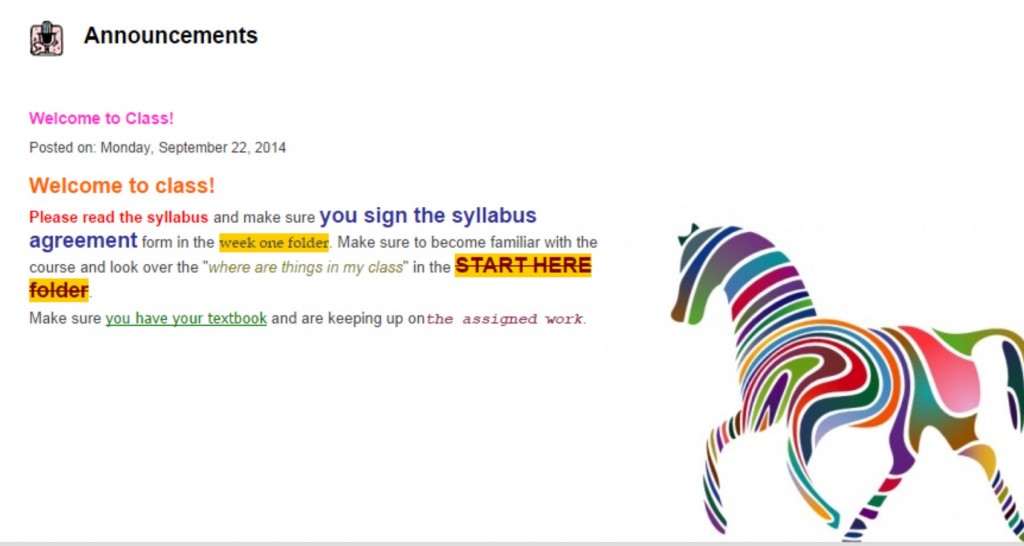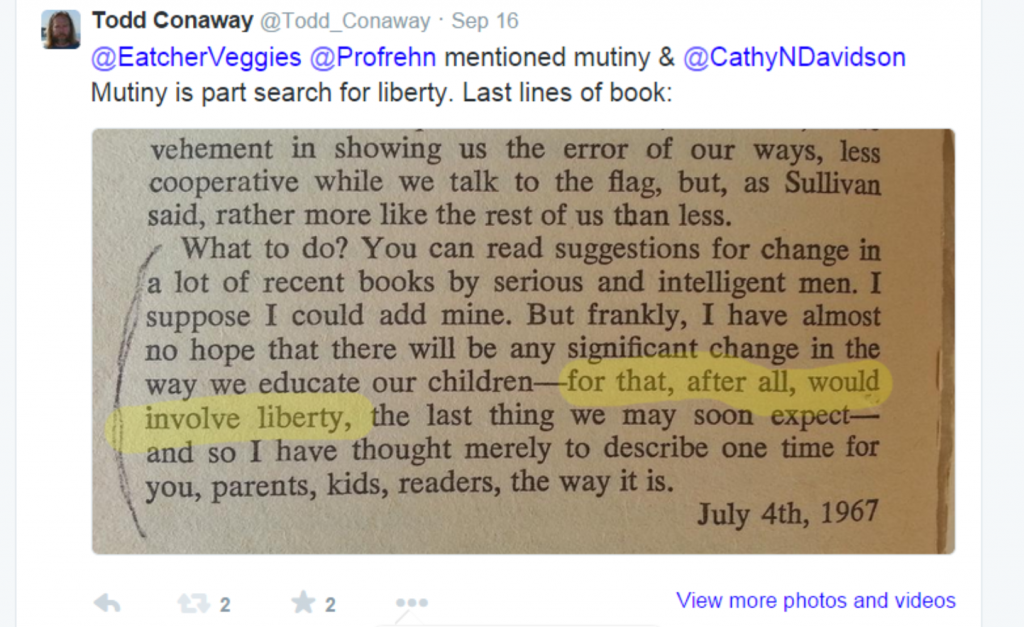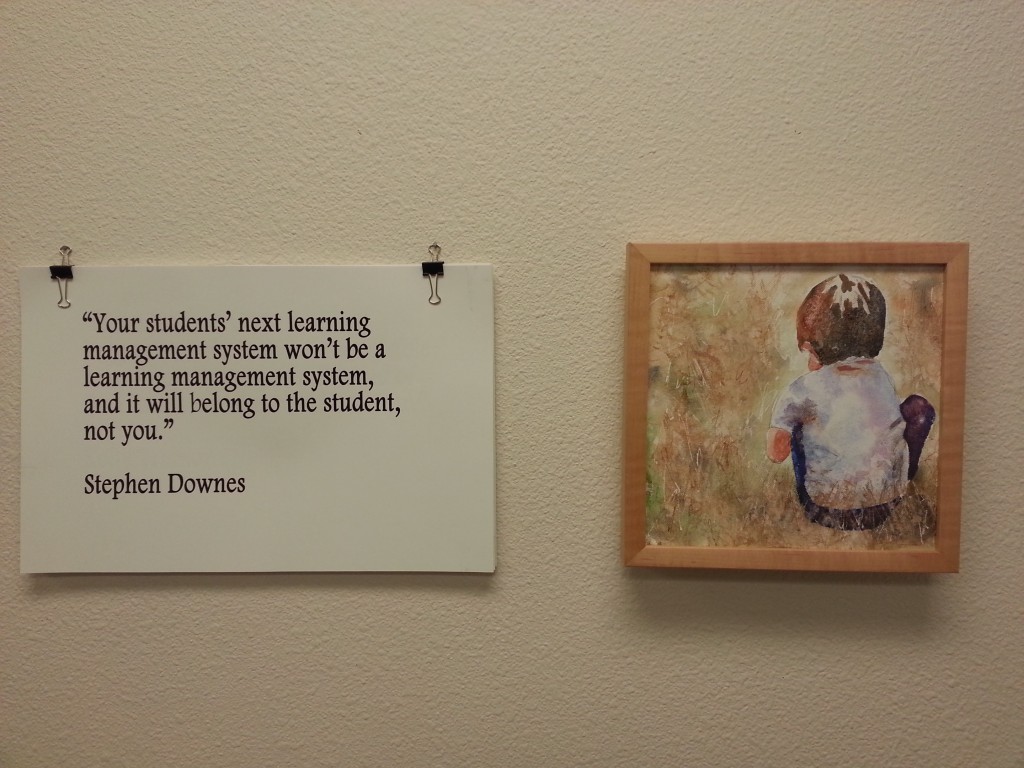I am working on a presentation titled, “Bells and Whistles.” I am working on it as I write. Who knows, maybe writing this will help clarify some of the thoughts I have?
I have an idea looking at technology in education as a mass of stuff that, in some cases, has become that now infamous “ubiquitous,” and in other ways much was still seen as unnecessary “bells and whistles.” So just what are those bells and whistles one wonders? Can you think of one?
An easy one for me to identify are those hideous options in PowerPoint that allow you to deliver, magically flipping around on the projection screen one letter at a time, the characters in a word that is in a bullet pointed list. Only more disturbing, is the faculty who sits and watches it fly around on the screen along with the audience. You have seen them at conferences or in classrooms. Just because your software can do something, does not mean you need to use it.
Another for me is looking at a Blackboard course that has the text for a single assignment displayed in a multitude of colors, sizes, fonts, and font styles. You know, the due date is in dark red and bolded. The date is blue and italicized. The title of the assignment is bolded and italicized and underlined and is in dayglo green. Perhaps, some specific and clearly important part of the directions are highlighted in yellow and in bold and made into a different font altogether and in a larger size. Crazy.

I have other examples of what I consider “bells and whistles” but where the idea has led me is to the very nature of the LMS and how often tools that were seen as bells and whistles are now integral part of the web and the learning opportunities that can happen using it. Yet, the LMS platforms themselves are still built and used as “management” tools. So I have been pondering the role of “management” in learning and how too much or too little can cause all kinds of problems.
Recently, that has sparked some interesting interactions.
I have first gone back to one of the best pieces of writing about the LMS I have read. In 2009 Lisa Lane offered us “Insidious Pedagogy: How course managements systems impact teaching.” You can read it here. One of my takeaways has been the notion of “the fault of the defaults” and how what is given to faculty often tells them how to teach. Be it the rows of ordered chairs or tables in a classroom or a LMS platform, the default a faculty is presented with often drives the structure of their classroom/online pedagogy.
I can tell you what the bells and whistles are now. They are the things that are not in the defaults of the LMS. Or at least they are often seen as such. I can say that with some authority because while we are making decent strides in using the whole of the web as educators, most of us are still only using the management tools found in the default settings the LMS has provided us with.
So what do we do with all those tools out there when in many cases they are not supported by the institution? Obviously important as well are the capabilities of our students when it comes to these tools and types of interactions. And what about the already overworked faculty person? Well, we are on a slow path to improvement in many ways and this is a just a part of it.
Some things I would like to get across in the talk in November.
- Don’t let your pedagogy be managed by the LMS (or a classroom for that matter)
- Clearly define the goal/outcome before you select the tool/strategy you will use to achieve it
- What were “bells and whistles” yesterday or important parts of the internet today
- Over-management of learning environments removes the possibility of discovery and developing self-directed learners
I am trying hard not to bash the ol LMS. I think is a part of how we organize our institutional information and a place we can start from when it comes to the internet as a tool in learning.
The images below are in my office. I think the two together share what I see as the potential for students to engage in a meaningful way the discovery of the world around them and be responsible for, and own, the work they do. I was going to used “student centered” in the last sentence, but there were already too many edujargonish words in there. Sorry.
In the mildly satirical video below, my daughter and others go about creating some pretty amazing stuff with what might be considered “bells and whistles” in education. I assure you they are not. I tried to contrast the capability of the web and her understating’s of it with what we often expect, at least at the technical level, in our classes.


I like where you are going with this after our first round of discussion. I was just browsing my feed reader and am so glad I found the Anime Story video, it fits well for my talk about the difference of being “on” the web and “of” the web.
I used a different example a few years back of my friend showing me a stop motion animation his son and friends did. The thing was they were sitting around as teens do, and one of them asked if the others knew how to make one. And thus they researched, planned, and produced a brilliant video. It’s the fact that kids, in their spare time, and interest, are not sitting there listening or watching media like I did, but they are doing creativity in their spare time.
Away from school.
It is getting clearerish. I had two folks at the Verde cybersalon today and I talked it out with them as well. Good to go back and read Lisa’s article. So insightful. I have some ideas about bells and whistles and audience participation ( http://www.orientaltrading.com/metallic-silvertone-bells-a2-41_2057.fltr?Ntt=bells )
This is going to be my first 9x9x25 post for next week. I think.
Emma said she would do a “What I think I learned from the Anime days” video. That could be good. She is so brave now at 16…